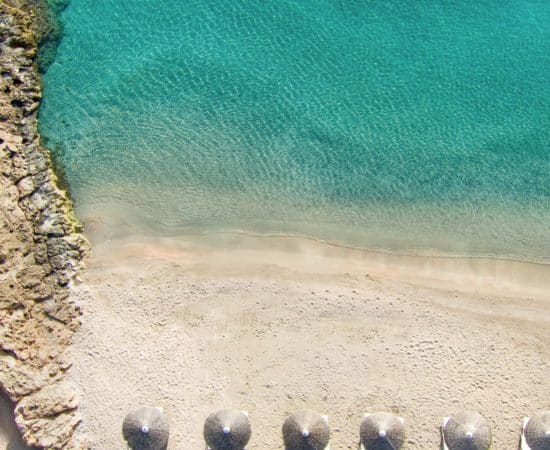Kalyves
The quiet, relatively unspoiled village of Kalyves is 20 km east of Chania and 40 km west of Rethymno, on the north coast of Crete. The area manages to combine the scenery of woods, hills, and mountains as well as trees, with the amazing Greek sea and the original rustic Cretan architecture. The main sandy beach is about five hundred meters long, with big trees for natural shade. Along the beach, there is a number of taverns and cafes, to serve your appetite with traditional Cretan cooking.
The village is built in an amphitheater form along the beach among two hills and the river that divides the village in two aspects with graphics bridges which gives the area a totally different sight. Thanks to the rivers flowing through, Kalives is located in a fertile valley and is full of green and surrounded by olive groves. Due to this fertile soil and strategic geographical location at the entrance of Souda Bay, Kalives has been inhabited at least since the ancient times and this is something magical that you will see for your own.


Plaka and Almyrida
Almyrida is located only 4 km east of Kalyves and until recently, Almyrida was just a fishermen’s village but due to its wonderful Mediterranean climate, sandy beaches, and its beautiful nature, the village has recently become a popular destination. Almyrida has two, nice, sandy beaches, with shallow waters, safe for children on wave-free days. The two beaches are separated by a small rocky pier peninsula, with a small white chapel. The taverns on the beach are famous for fresh fish and delicious traditional Cretan food. There are regular bus services and taxis (for both Plaka and Almyrida) to/from the city of Chania.
The unspoiled countryside and the lush olive groves around Almyrida are ideal for hiking and exploration. Just 1km to the east there is the picturesque village of Plaka, which is the largest village in the region. Plaka is famous for its healthy climate, unforgettable sunset and the hospitality of the locals. Plaka has a lovely main square which is the focal point of the village. This is where locals and visitors, alike, meet in the cafeterias and tavern.



Chania
It’s easy to fall in love with Chania, with the colorful, paved pedestrian streets, filled with welcoming shops and restaurants for visitors to explore. The best part is the historical old town, as most of the sights are located there, and the harbor that was built by the Venetians in the 14th century.
A lot has changed since then, but the Venetian lighthouse is still standing proudly. It’s one of the oldest lighthouses in the world. There are many restaurants and cafés around the harbour where you can sit and enjoy the breathtaking sunset and the fresh scent of the sea. Explore the old Turkish neighborhood of Chania’s old town – there you will spot one of the most significant churches of Chania, ‘Agios Nikolaos’, hosting both a bell tower and a minaret, demonstrating the multicultural character of this town. You can also visit the town’s central market, to buy meat, vegetables, cheese, spices and a lot more. The Archaeological Museum is impressive, with findings dating from the Neolithic Age to the Roman period, as are the Grand Arsenal which was built during the 1600s, and is now used to host events and the Venetian Dockyards, built in the 16th century, used by the Venetian to repair their fleet.


Rethymno
Situated in the heart of the island, Rethymno is built by the sea and is a city with many faces. Rethymno or Rithymna, as it was once called, has been inhabited since the Later Minoan III period.
Nowadays, it keeps the elements inherited from its history but with the characteristics of a modern city. The charming old town of Rethymno still retains its aristocratic appearance. Venetian, Byzantine and Turkish influences are strongly visible in the old town. In the old town, the Venetian Harbour is filled with fishing boats and lined with taverns. Rethymno is a city that very much caters to the needs of its visitors. Throughout the year various events and festivals are organized by the local people. There is a whole array of café bars, taverns and restaurants, catering to every taste, in which to sit back and relax. Lively nights out are part of Cretan life and there are plenty of bars and night clubs to choose from. The Greeks certainly know how to enjoy themselves and their hospitality is famous, especially in Rethymno. It was, after all, the home of Zeus, the God of Hospitality! As you can see Rethymno has a lot to offer, and the island as a whole, even more.



Aptera
The archaeological site of Aptera was founded in the 8th century BC in a panoramic position which was the most powerful city of western Crete during Minoan times, is located only 8 km from Kalyves.
According to tradition, it got its name from the Sirens who lost their wings after losing in a musical contest against muses, so they stayed wingless (aptera in Greek). However, it apparently got its name from Aptera Artemis (wingless Artemis) that was worshiped in the area, as evidenced by the coins of the city.
At the archaeological site, you will be able to admire findings of all periods of inhabitation of this City-State, everything that could not be transferred to the Archaeological Museum of Chania.
